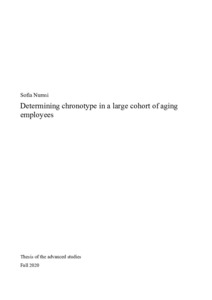Determining chronotype in a large cohort of aging employees
Nurmi, Sofia (2020-12-07)
Determining chronotype in a large cohort of aging employees
Nurmi, Sofia
(07.12.2020)
Julkaisu on tekijänoikeussäännösten alainen. Teosta voi lukea ja tulostaa henkilökohtaista käyttöä varten. Käyttö kaupallisiin tarkoituksiin on kielletty.
avoin
Julkaisun pysyvä osoite on:
https://urn.fi/URN:NBN:fi-fe20201223102867
https://urn.fi/URN:NBN:fi-fe20201223102867
Tiivistelmä
Chronotype refers to one’s daily behaviour regarding their sleep-wake cycle. It can be divided into three categories: morning, intermediate or evening type. Chronotype has an effect on health and behaviour, as especially evening type has been associated with sleep complaints and mood disorders. Chronotype can be assessed with different methods, such as physiological measurements, device-based monitoring and subjective measurements, such as questionnaires.
The purpose of this study was to compare different methods of determining chronotype among Finnish aging employees and to choose the best method for the Finnish Aging and Retirement (FIREA) study conducted at the University of Turku. FIREA study is an ongoing longitudinal cohort study established in 2013, which aims to examine health behavioural and clinical risk marker changes during the transition to retirement.
This thesis is a literature review and its materials have been collected from the Turku University Library’s databases using search terms such as “chronotype”, “questionnaire” and “measure”. It is based on peer-reviewed articles. By comparing results from different studies and utilizing other reviews, a comprehensive review of different methods of determining chronotype is assembled and the best suited method is chosen for the FIREA study.
As the basis of the study is a large cohort of aging Finnish public sector employees, methods that require laboratory environment or tools have to be excluded. Methods that suit large epidemiologic cohort studies are questionnaires and actigraphs. When comparing them, the best choice for the FIREA study is the shortened Mornigness-Eveningness Questionnaire, as it is translated and validated in Finnish and is easy to carry out. It is also possible to further validate the questionnaire with actigraph measurements.
The purpose of this study was to compare different methods of determining chronotype among Finnish aging employees and to choose the best method for the Finnish Aging and Retirement (FIREA) study conducted at the University of Turku. FIREA study is an ongoing longitudinal cohort study established in 2013, which aims to examine health behavioural and clinical risk marker changes during the transition to retirement.
This thesis is a literature review and its materials have been collected from the Turku University Library’s databases using search terms such as “chronotype”, “questionnaire” and “measure”. It is based on peer-reviewed articles. By comparing results from different studies and utilizing other reviews, a comprehensive review of different methods of determining chronotype is assembled and the best suited method is chosen for the FIREA study.
As the basis of the study is a large cohort of aging Finnish public sector employees, methods that require laboratory environment or tools have to be excluded. Methods that suit large epidemiologic cohort studies are questionnaires and actigraphs. When comparing them, the best choice for the FIREA study is the shortened Mornigness-Eveningness Questionnaire, as it is translated and validated in Finnish and is easy to carry out. It is also possible to further validate the questionnaire with actigraph measurements.
